Spatial Intimacy in Stalker 2’s The Zone
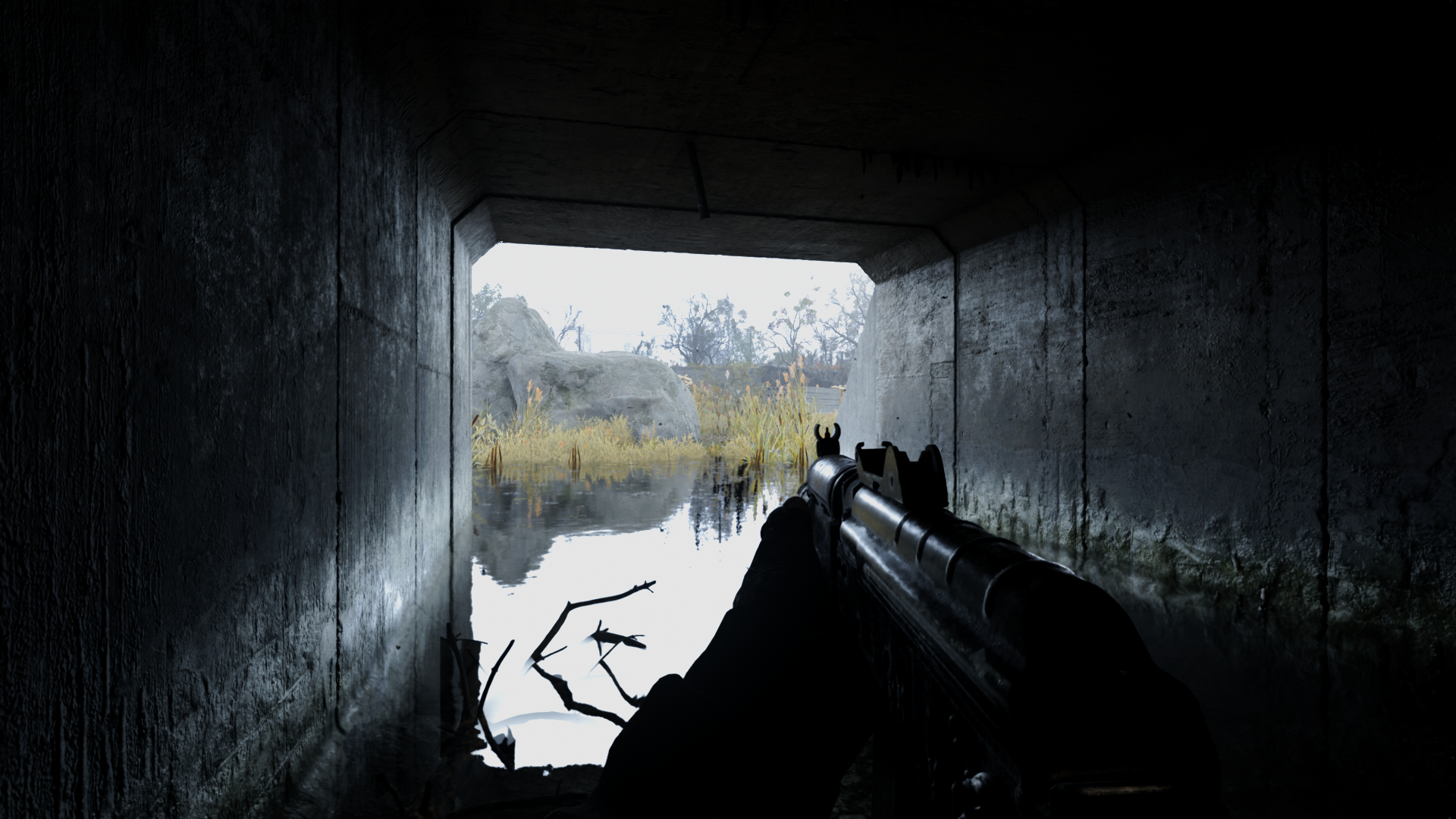
In Stalker 2, the player must become intimate with the Zone.
This intimacy is borne out of, in part, the standard ways any open world game breeds familiarity and engagement with its world: Stalker 2 requires you to go from one place to another, this act of moving between locations takes time, and often it requires moving through other locations or encounters on your journey. You may get into fights, which drain resources, or find loot, which increases resources. Too many resources and you move slower and are more vulnerable to attack. Too few and you may not be able to survive the next fight. So you slowly plod through the environment, taking wide berths around danger and exploring / looting when in relative safety. Occasionally, safety reveals itself to be danger, or vice versa, and the surprise is notable and requires you to adjust your intuitions. This is good, fun, video game-y stuff, and Stalker 2 executes it all well. But I would not yet describe this as intimate.
The first mechanical aspect that genuinely endears the player to the Zone are the anomalies. Anomalies are strange and supernatural phenomena, with dozens of types revealing themselves over the course of the game. While rarely consciously hostile, many can damage the player just via contact, and thus they need to be vigilant when exploring. This is especially true because most of the time, the anomalies are functionally invisible.
One of the most common anomaly types is essentially an air bubble, only visible via a slight spherical distortion it applies to the frame around it, that ranges from half a meter to 5m or even 10m wide. If the player walks into it, they burst the bubble, causing the pressure to crush the player for a massive, near lethal amount of damage. Within a couple seconds, the bubble will return, and if the player hasn’t moved in that time, it will crush them again. Other anomalies include scorched floors that burst into flame cyclones when the player steps over them, small whirlwinds of debris that launch the player if they enter them, and, my personal favourite, fields of floating glass that cut the player's skin as they walk through.
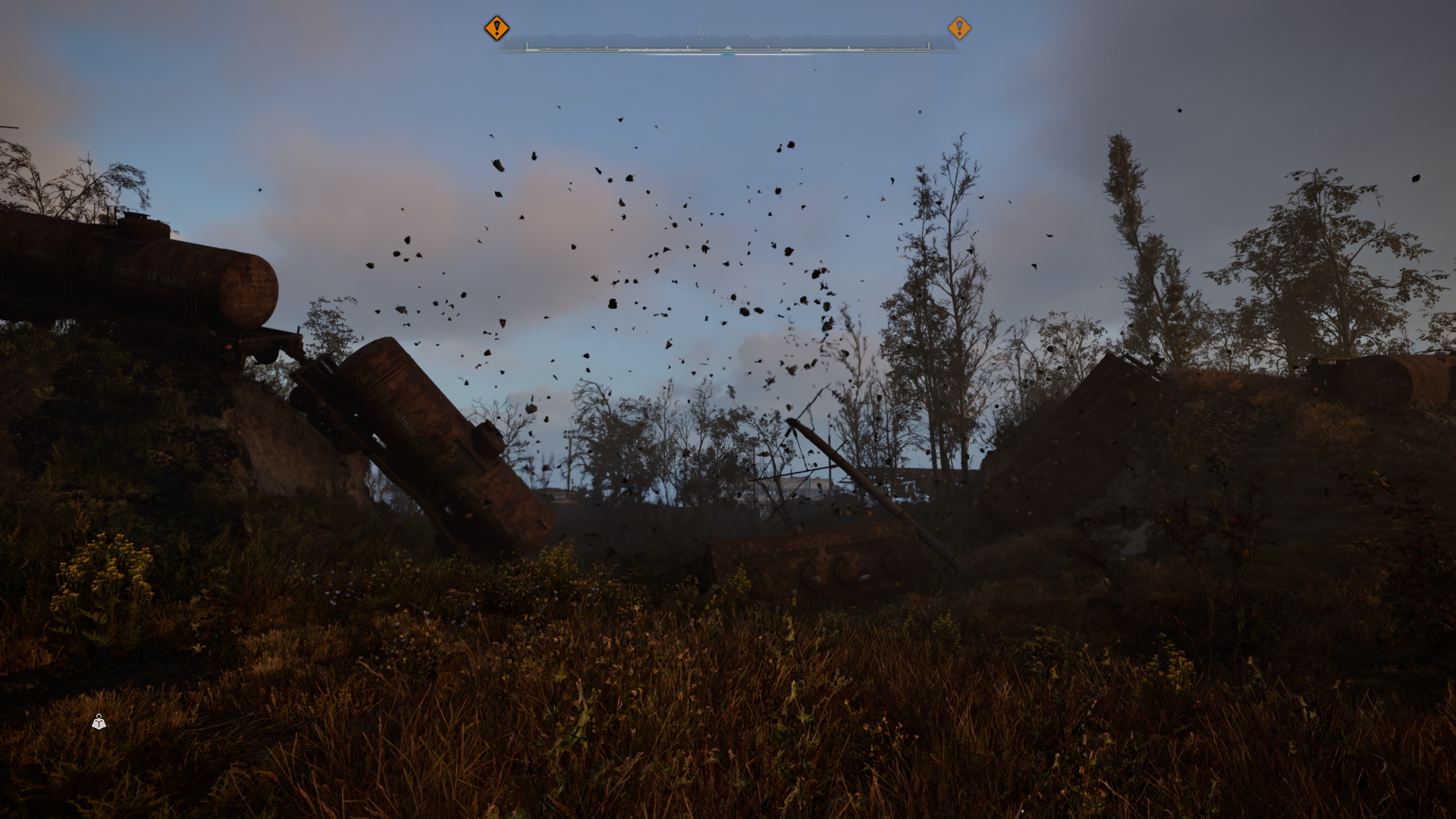
There are non-visual indicators for the anomalies, like an audio cue that adjusts in frequency relative to the player’s proximity to an anomaly, and the player is able to throw bolts to try and trigger an anomaly from a distance. And sometimes, like in the image above, larger scale anomalies can signal that there are smaller ones in its orbit. But it's those base visual tells that, however slight, becomes the most important. Spotting an anomaly at a distance allows the player to plot a safer path around it, or bring combat encounters to it so that it can function as a defence or weapon. Equally, many NPCs in the game store loot in areas with anomalies, meaning that they are often worth exploring so long as players can find a safe root to navigate them.
Anomalies thus serve a dual purpose. For one, the player cannot trust that the walking between major locations will function as “downtime”. Any area may hold an anomaly, and if the player is not vigilant, they may be hurt or even killed by one at any time. At the same time, by having the level design and world-building engage with the anomalies, this vigilant, mechanical engagement becomes narrative engagement. The player wonders what the anomalies are, or why they specifically occupy a specific area, or how other people may have reacted to these situations. Their strange forms and visual appearances endears the player to observe and understand them, even if they are dangerous and unpredictable. This all, in turn, sparks that intimacy within the player. It’s not just about surviving the Zone, but knowing the Zone, and intuiting your place in it.
That this mechanical intimacy is seemingly reflected in or shared by other characters in the world pushes the player to try and understand the history of the Zone and its people. I use the word “history” over “lore” here intentionally. Lore, while important and useful in its own right, implies the kind of world-building that might only explain the base nature of the player’s current surroundings, and in turn might not be materially useful to any situation the player encounters. But this is not how Stalker 2 treats its history.
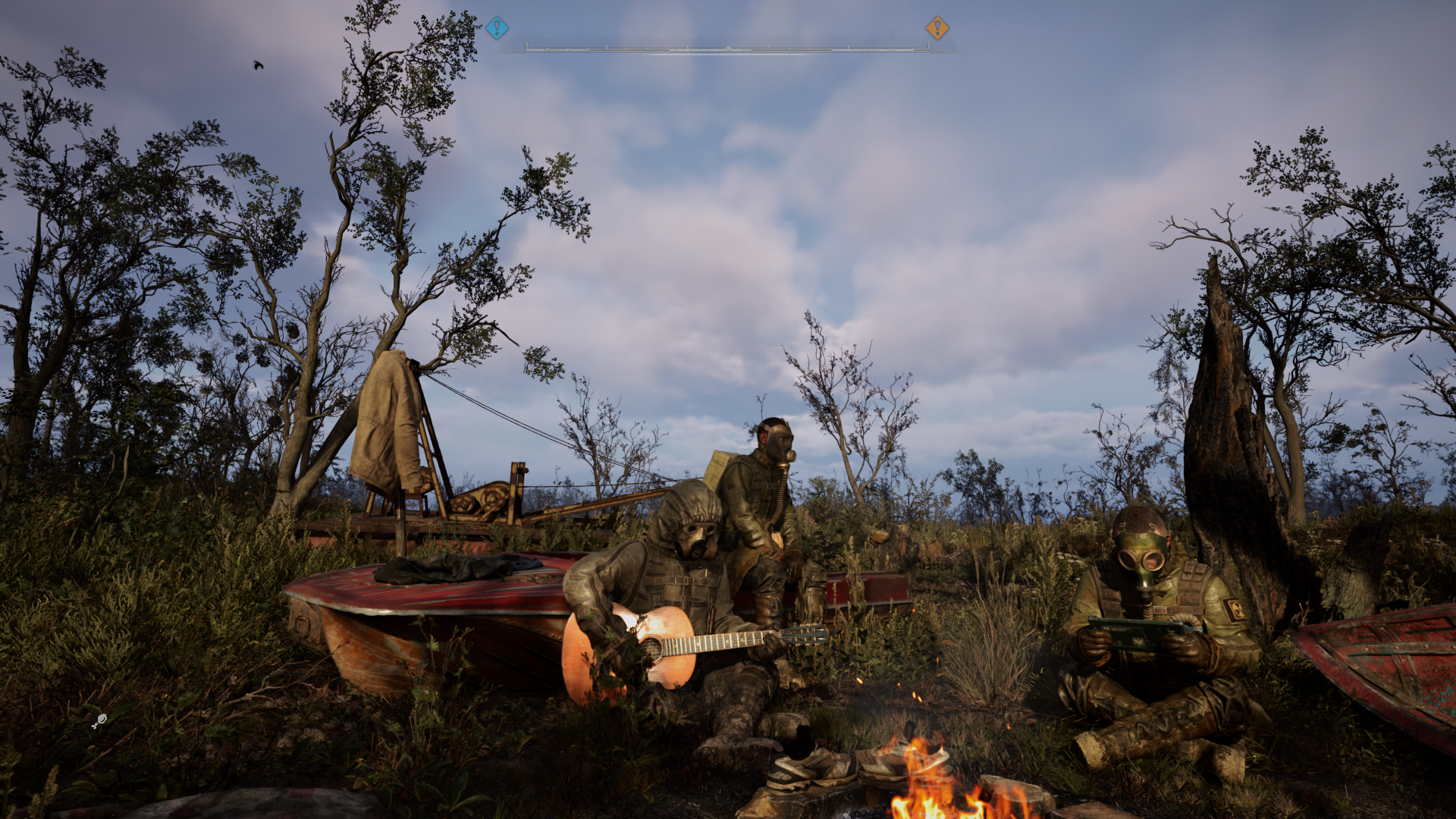
Take Wild Island. Wild Island was (as I understand it) the end goal of Stalker: Shadow of Chernobyl. It’s an island with only a few small, half-flooded and anomaly infested land bridges to approach it by, and in the past it was defended by dozens of mind-controlled Stalkers called Monolithians. In Stalker 1 it was the home of the “The Wish Master”, a character who could grant any Stalkers’ wish (for a price). In Stalker 1’s ending (now Stalker 2’s history), that game’s main character, Strelok, killed the The Wish Master and freed those enslaved by it. But in Stalker 2, Strelok is still there, along with nearly all of the surviving Monolithians.
Talking to Strelok and the Monolithians, they provide good answers for why they never left Wild Island. The Monolithians were freed from their mind-control, but didn’t get back any of their memories. As a result, because the Monolithians don't know how the outside world functions, nor even who they were in it, it's not clear how they would manage to survive anywhere but the Zone. Strelok, being the person who freed them, felt indebted to take care of them, and helps manage and provide for the community. Strelok does allows Monolithians to leave the island if they wish, but he highly discourages it. Even if a Monolithian wanted to leave the island but stay in the Zone, many in the Zone are prejudiced against the Monolithians for their past actions, and will attack Monolithians on sight. So, the reasoning by which many Monolithians choose to stay on Wild Island seems to make alot of sense.
Yet, many Monolithians disagree with, or at least push back on, this perspective on their situation. The island they live on is mostly just a dessicated old bunker, one that is actively irradiated and holds many dangers of its own, Monsters hang on on the nearby coasts and forest, and when you first arrive there's a zombie hanging out on the roof of the base that no one has the heart to kill. Many Monolithians you talk to wonder why they couldn't just move elsewhere, reamining united as a community but without all the dangers present on the island or in the Zone generally. The aforementionned zombie, and a later quest that has you encounter some Monolithians just off-island who died to mutant capable of mind-control, imply the Monolithians are perhaps more mentally succeptible than most humans in the area. Meanwhile, your conversations with Strelok and other characters heavily imply that Strelok has his own fears about leaving the Zone, ones he may be projecting onto the Monolithians in his care.
The player, rather than just witnessing this complex situation, is actively invited to participate in it. Multiple side-quests in the area require you working with specific Monolithians to undermine Strelok, or have you learn about some Monolithians who are attempting to leave, and those who have already left. But perhaps the most interesting element of this is that the player can deny these side-quests if they don't allign with the player's perspective on the situation. There are even lines of dialogue that allow the player to express that this is, in essence, a Monolithian struggle, and not one they feel comfortable intervening in. These sidequests are thus illustrated to not be just about loot or experience, but worldview and consequence. The result is a sense that the situation on Wild Island is alive, and that even being passive about it is a meaningful choice that may have an impact later.
This narrative design approach, which is present across just about every community and quest in the game, results in this feeling of the Zone having a living and ongoing “history”. This is especially heightened if the player has played previous Stalker games, as many areas from those games return not just with shared layout or details, but even updated narrative stakes (like with an endgame boss area now being a settlement in Wild Island). The player’s own history can thus become part of the history of the Zone, and inform the way they interact with the space. This all results in the player feeling as though their actions are capable of carving history into the landscape of the Zone, with a scale of output that is nearly impossible to predict. When the player can, intentionally or not, enforce their politics on the world via simple mechanical engagement, they are encouraged to care about their actions and care about the Zone, lest they bring about a consequence they do not believe in. And with care, once again, comes intimacy.
So with mechanical intimacy and narrative intimacy, there is one more way that intimacy can also emerge within the Zone, and it is perhaps the simplest: The Zone can be pretty.
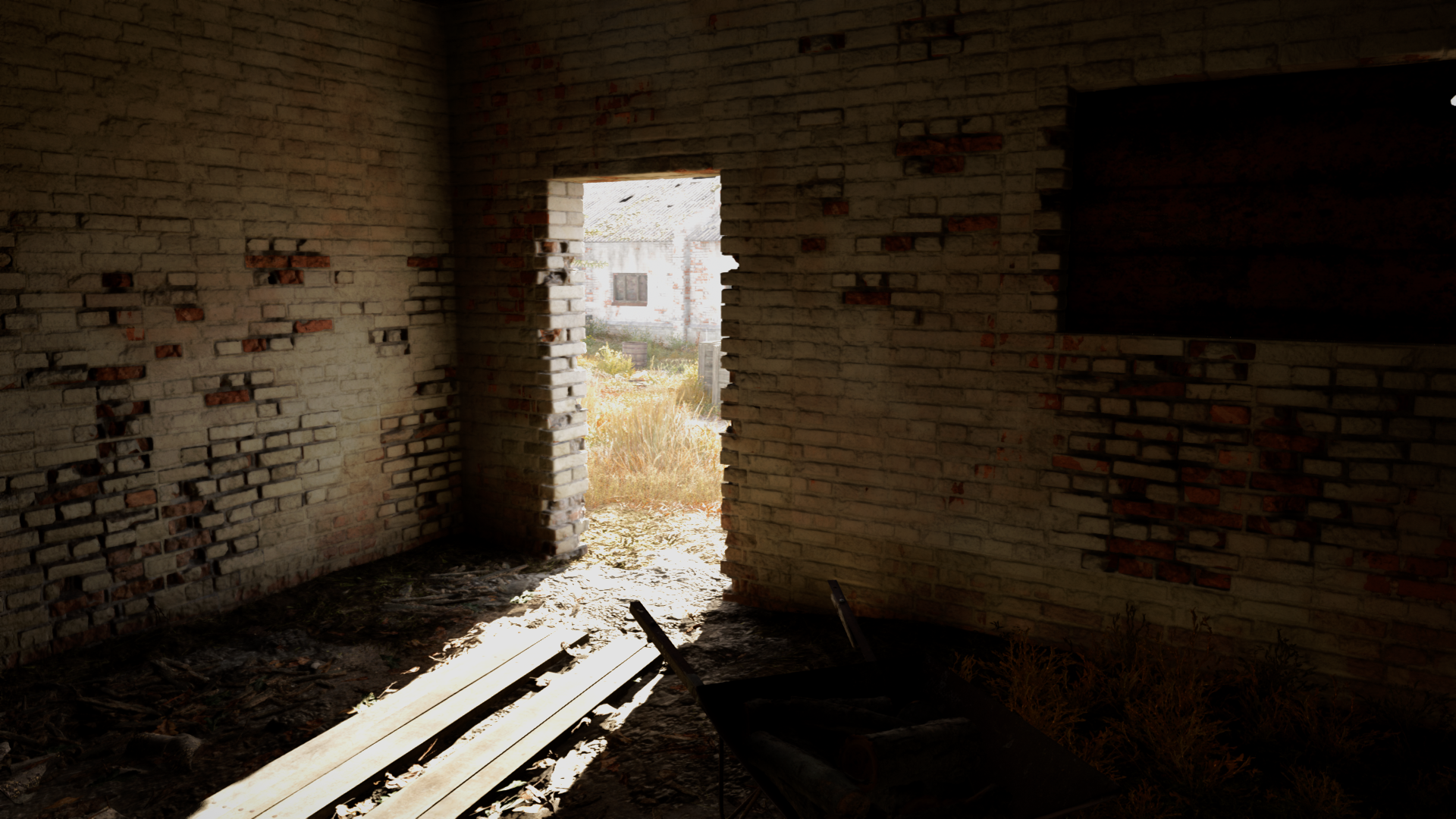
"Can" is the operative word there. Often the Zone is actually pretty ugly, for a number of reasons. To get briefly technical, Stalker 2 essentially requires a temporal rendering solution to cover up massive issues with aliasing alongside noise / inconsistencies from their lighting set-up. However, using these solutions doesn’t particularly solve them (I’m using DLAA at 1080p, for reference). Grass is less jagged and pixelated, but in motion grass can look almost liquid, as various blades are combined and separated between frames. And while indirect lighting is less noisey, it remains blotchy and inconsistent from frame to frame, especially after quick camera moves when the game hasn’t had time to get enough temporal information from the screen.
These technical woes combine with intentional art direction decisions, especially within the game's weather system. The Zone feels like its in its grim, late autumnal / early Winter era. Most things are various shades of decayed brown, and the sky is often overcast and drizzly, which has an effect of often desaturating and decontrasting the whole scene. This, combined with the aforementionned technical issues, can blur the whole world together into a sort of brown, grey sludge that can be very hard to parse. And if its nighttime, then just imagine seeing the same brown, grey sludge, but only for the few feet in front of you that your flashlight allows for. Past that, the world fades into an oppressive and impenetrable dark.
The thing is though that, despite how we may feel about how the game arrives at the above, it doesn’t feel inconsistent with our understanding of the Zone. The Zone is weird and gross and complex, it’s hard to parse and hides secrets. If a bit of DLAA smoothing and lighting flickering and an overall muted image helps hide an already semi-invisible anomaly, then isn’t it just on the player for not stopping earlier and more diligently peering into the distance? If the player can’t trust the Zone, why should they trust the engine the Zone is running on, or the artistic choices it’s developers made?
This overall intentional grimness and smear means that when the Zone does decide to be pretty (and it does feel like it’s deciding to), it is truly beautiful. This is especially so in interiors where light penetrates through windows and cracks, which then bounces around to ambiently illuminate the decaying remnants of humanity, but just as much applies to the sun flitting through the ever moving foliage of the trees. The fine details of the game, from beautifully detailed, uniquely tiled bus stops to carefully arranged fields of flowers, can catch the player off-guard even in heightened, dangerous situations. And this beauty is enhanced by its rarity. A beautiful sunrise may only be glimpsed after trudging through a dangerous night, and minutes later it might just be replaced by cloud and rain. This rareity is perhaps most notable in severe weather states called “emissions”, which have the sky turns bright red while lighting flashes across the sky. To survive these emissions, the player is required to hide inside of boarded up buildings or bunkers. The beautiful and unique weather state can only be glimpsed through the cracks in boarded up windows, only fully felt during the dangerous sprint to safety. Thus this beauty isn’t just due to the game’s “realism”, nor is it technical successes, though undeniably some element of both is at play and deserves credit. It's more acutely because, as everything we have discussed here does, it places the player in the material reality of the Stalker.
Stalker 2 is a game about the Zone, narratively, mechanically, artistically and thematically. The Zone is large, dangerous, ugly and, in so many ways, deeply unfun to inhabit. Yet, for the game to work, the player must learn to not just understand but intuit the nature of the Zone. So the anomalies serve as a vector for which the players are forced to learn to intuit the Zone mechanically, to see how it hides both danger and opportunities in the same breath. In turn, the player engages with the various histories of the Zone, and by being confronted with meaningful choices about them, the player learns to care for them. And the player encounters beauty. Pure, simple aesthetic beauty, in places that may have seconds earlier been ugly, and may seconds later be ugly again. And if the Zone is capable of aesthetic beauty, then maybe its capable of narrative beauty, of mechaniiical beauty. The player just needs to understand the Zone, to care for it, to predict it and respond to it. And that is, in its way, intimacy.
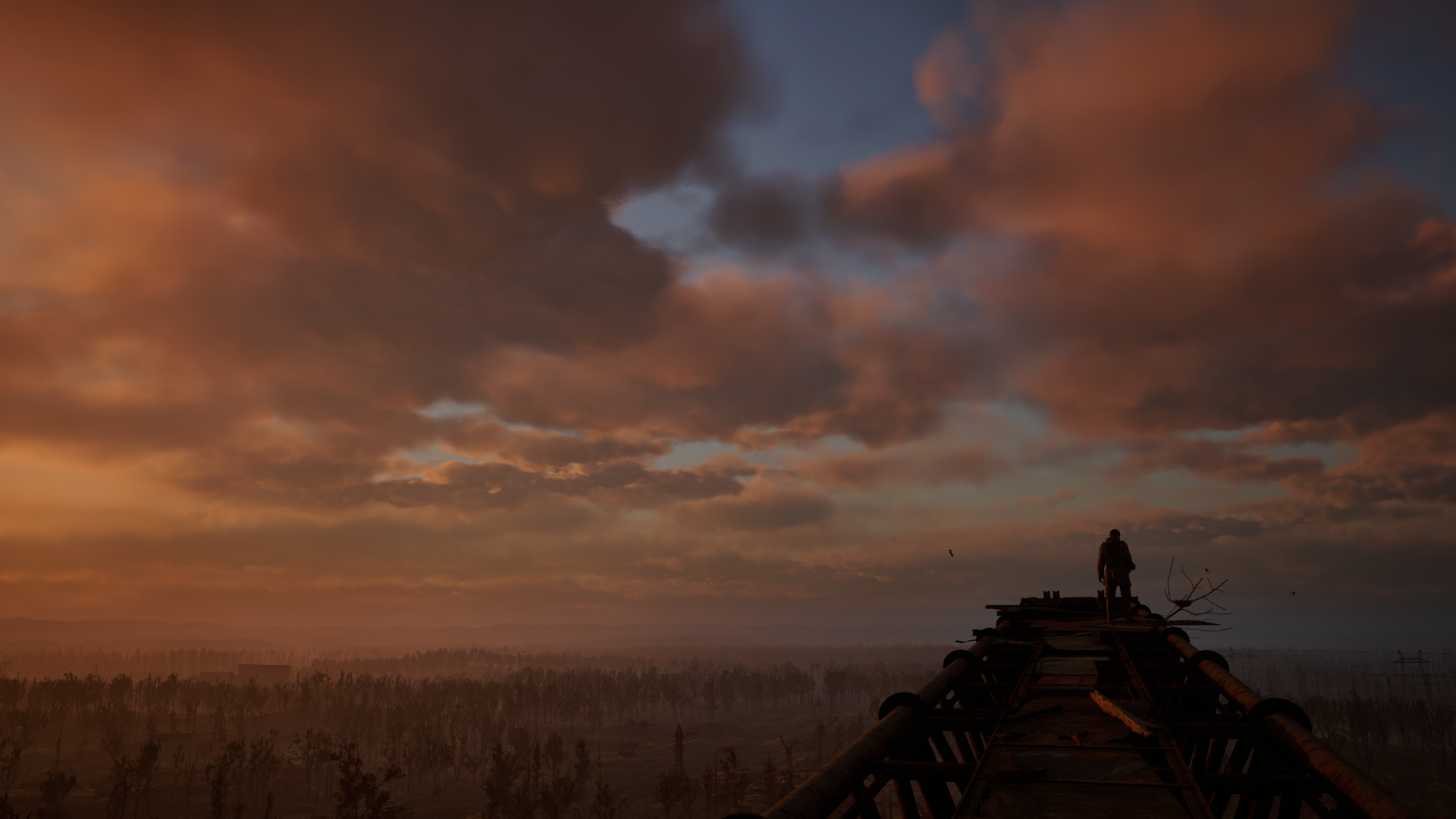
How one translates this intimacy to other games, I don't know. Weirdly, I felt similar feelings watching people play through the Museum of All Things, a game that Wikipedia into a museum that can be walked through, complete with benches, lighting rigs and marble floors. I think you could relate this notion of "Intimacy" to the notion of "Player Fantasy", that both the role of the Stalker and the museum goer is understanding, and that both have a world that adapts to and pushes against that fantasy. Both enforce the idea that the player cannot simply summon their desired state of the world, that the world is bigger than themselves and defined by its own rules, and that all the player can do is respond to it. But that in learning how to respond to the world, and learning how the world responds back, the player and the world may work together to achieve their goals. The player is thus encouraged to build a model of the world, and, in turn, each surprising response from the world becomes something that changes the players internal model, and something they will try to understand and look out for in future.
Intimacy is, in essence, this act of prediction. It's not just about two or more actors engaging with one another, but intuiting one another, the joy of a correct prediction and the surprise / safety of being predicted. Intimacy equally comes from the ways in which actors navigate conflicts or faults within their predictions, and the route from that conflict back to safety. Intimacy cannot be bred from simply being served, which is likely why games of pure power fantasy don't have quite this same notion of intimacy within them. There must be back and forth, call and response, highs and lows. To have a game pursue intimacy is tricky, because it requires the design to accomidate and challenge a wide-range of player behaviours and actions. But it's worth exploring how we endear this intimacy, because it is that personal connection, that active conversation between player and game, that makes our medium so unique.